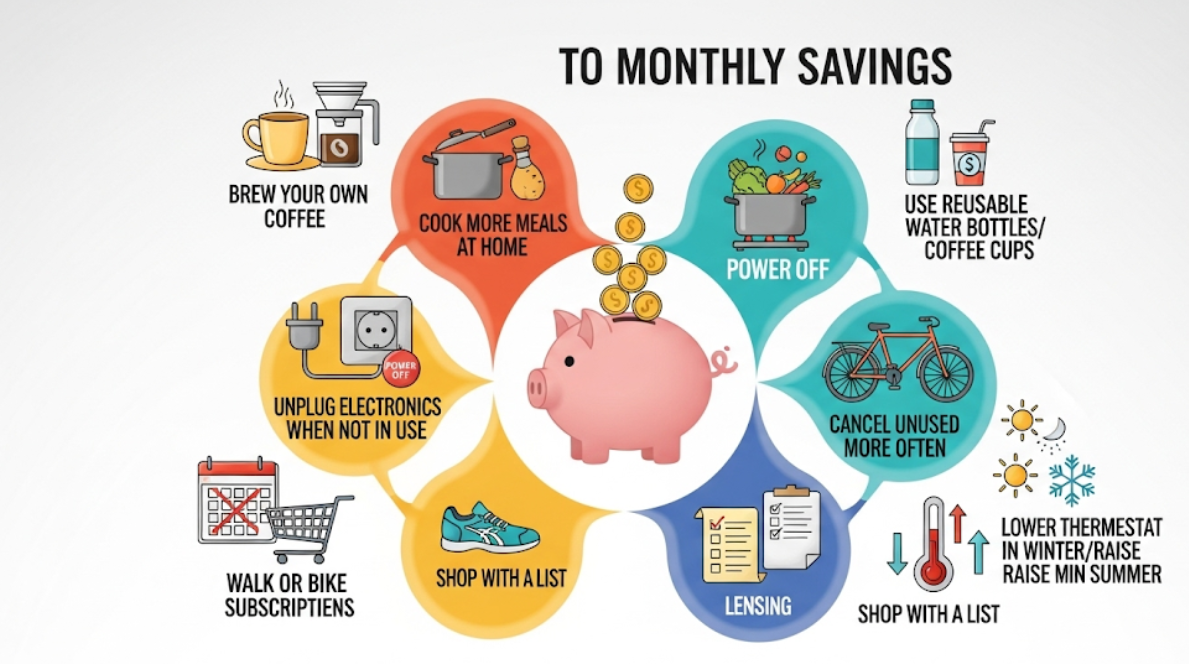More Money Saved Than They Made in Every Month: Lifestyle Changes for Big Financial Gains
Most families are feeling their money stretch thin these days. Stretching each dollar is tougher than ever with the cost of groceries rising, gas prices up, and those unexpected bills cropping up. Well, how about we tell you that some small adjustments to your daily routine could see hundreds of dollars back in your bank account every single month?
You do not have to go to extremes or live as a monk in order to save money. It all comes down to minor tweaks that feel hardly like changes at all. Over the long term, these uncomplicated lifestyle adjustments can equal serious savings in your financial budget and give you the knowledge that your finances are finally under control.
But in reality, some of the savviest money-saving tactics are being put to good use by ordinary people. You’ll see how little changes in your day-to-day can make massive differences in your money from morning coffee routines to weekend fun.
Kitchen Habits Save More Money in Your Pocket
Cook More Meals at Home
On average, an American family spends more than $3,500 annually on eating out. That’s nearly $300 every month! Avoiding ordering in just three times a week and cooking at home can save you $150-$200 each month.
So, to get you started on your journey, here are 4 easy swaps to make! Start small, my friends.
- Meal prep on Sunday — spend two hours getting ingredients prepared for the week
- Convenient one-pot meals like stir-fries, pasta, or soup
- Use leftovers: Transform yesterday’s evening meal into tomorrow’s lunch
Example: Sarah from Denver used to get pizza delivered 2x a week (totaling $30 each). On Sundays, she began to make pizzas for the whole family. Her monthly savings: $240.
Smart Grocery Shopping Strategies
Your store receipt doesn’t have to swallow half of your salary. By making these simple changes you can reduce your food costs by 20-30%:
- Have a list: Those that grocery shop with them spend on average 23% less
- Purchase the store brand as opposed to a name brand = often 25%-40% cheaper
- Apply the 24-hour rule: For items purchased on impulse over $20, give yourself 1 day before pulling the trigger
- Shop the perimeter: Whole, fresh foods in all outer aisles of the store are almost always cheaper per serving
| Shopping Strategy | Average Monthly Savings |
|---|---|
| Generic brands | $40-60 |
| Weekly meal planning | $80-120 |
| Bulk buying (non-perishables) | $30-50 |
| Seasonal produce | $20-35 |
Reduce Food Waste
Typically, families waste $1,500 per year in lost food. Here is how to chop this wastage in half:
- Pop herbs in water in the fridge & avoid bananas sitting together
- Implement a “First In, First Out” rule in your pantry
- Make smoothies (fruit or veggie) or soups out of sad veggies
- Freeze the stuff you won’t use instantly
Budget-Busting Transportation Tricks
Rethink Your Daily Commute
For the most part, after housing, transportation is your second largest expense. Here is where small adjustments provide large savings:
Carpooling and ride-sharing:
- Ride with coworkers (saving $100-200 per month on gas and parking)
- Reserve a ride when needed instead of having a 2nd car
- Walk or ride your bike for errands under 2 miles
Car maintenance savings:
- Monthly tire pressure check (3% better mileage)
- Combine errands into one trip
- Take all the excess junk out of your trunk (every 100 pounds lowers fuel efficiency by around 2%)
Gas Station Strategies
Just these little habits can give you $20-$40 more in fuel each month:
- Gas apps like GasBuddy will help you find the lowest-priced stations
- Tuesday or Wednesday fill-ups (cheapest days, usually)
- Buy fuel when stations are offering cash discounts
- Save on gas with grocery store fuel reward programs
If you travel 12,000 miles per year and increase your mileage from 25 MPG to 28 MPG, you will spend $200 less every year.
Quick Home Energy Savings
Affordable Temperature Control
More than half of our utility bills go towards heating and cooling costs! These modifications don’t alter your comfort, but they do affect costs significantly:
Winter savings:
- Set thermostat 2 degrees cooler (saves 5-10% on heating bills)
- Use ceiling fans to circulate warm air
- Close vents in unused rooms
- Layer up instead of heating
Summer savings:
- Set your AC to 78°F while at home, and 85°F when away
- Use fans to make rooms feel 4 degrees colder without air conditioning
- Shut the blinds during the hottest part of the day
- Cook on the grill, not in the oven
Simple Energy Efficiency Tweaks
One-time changes that end up saving on a monthly basis:
- LED Light Bulbs – 75% less energy than regular bulbs
- Programmable thermostat – Automatically changes temperature when you are not at home
- Power strips – Stop “phantom loads” from electronics in standby mode
- Weatherstripping – Fill gaps around doors and windows
| Energy Change | Initial Cost | Monthly Savings | Payback Time |
|---|---|---|---|
| LED bulbs (10 bulbs) | $60 | $8 | 8 months |
| Programmable thermostat | $120 | $23 | 5 months |
| Weather stripping | $25 | $12 | 2 months |
| Smart power strips | $40 | $6 | 7 months |
Entertainment and Recreation
Free and Low-Cost Fun Activities
Not all entertainment needs to be expensive. There are a lot of low-cost or even free events and activities in most cities that are just as fun, if not more.
Free entertainment options:
- Library events (book clubs, movie nights, workshops)
- Community festivals and outdoor concerts
- Hiking trails and public parks
- Free museum days
- Beach or lake activities
Low-cost alternatives:
- Organize potluck dinners instead of restaurant outings
- Have game nights at home
- Organize walking groups with friends
- Attend matinee movie showings
- Go to farmers markets for free taste testing and music
Streaming Service Audit
Households subscribe to an average of 3.4 services, paying $47 per month on average. Streamline your subscriptions:
- Cancel unused subscriptions after 30 days
- Share family plans with relatives
- Rotate subscriptions seasonally
- Use free ad-supported versions
Example savings: Reducing 4 streaming services to 2 saves you $264 per year.
Smart Shopping and Consumer Habits
30-Day Rule for Non-Essential Purchases
If you are thinking of buying something over $50 and it isn’t a necessity, wait 30 days. You might be shocked at how many times you forget, or find a better deal elsewhere. This will save you hundreds of dollars in impulse buys.
How it works:
- See something you want to buy
- Write down what it is, the date, and price
- Wait 30 days
- If you still want it and can afford it, buy it
Most of the time, you’ll find out that you didn’t even need it in the first place.
Subscription Service Spring Cleaning
Quarterly, re-evaluate all of your subscriptions. Two-thirds of consumers have paid for a subscription they forgot about:
Common forgotten subscriptions:
- Gym memberships you don’t use
- Software subscriptions for old projects
- Magazine subscriptions that auto-renewed
- In-app purchases you used once
- Delivery services you rarely use
Takeaway: Review your bank and credit card statements for any recurring charges. If you have not used something in two months, cancel it.
Save Money on Clothes and Personal Care
Wardrobe Management That Saves Hundreds
You can be fashionable without spending a lot of money.
Timing strategies:
- Shop end-of-season clearances (save 50-70%)
- Buy winter coats in March and swimwear in August
- Use apps like Honey to check for coupons automatically before checkout
- Go to thrift stores in affluent neighborhoods for better finds
Care strategies:
- Use cold water to do your laundry (saves $60/year on energy)
- Hang dry when able (increases garment life by 30%)
- Learn basic hand sewing for repairs
- Choose quality over quantity for items you wear often
DIY Personal Care
Small personal care changes add up to $30-50 per month saved:
- DIY hair cuts (save $50-80 every 2 months vs. salon visits)
- Prepare homemade face masks
- Purchase generic pharmacy brands instead of name brand medications and vitamins
- Use baking soda as a natural deodorizer and cleaner
Technology and Communication Savings
Phone and Internet Bill Optimization
Many people pay too much for both their phone and internet service. Take these steps to shave 20%-40% off your bills:
- Call your providers each year and ask for any discounts or promos, including retention offers
- Check your data usage: You might be paying for more than you use
- Switch carriers: Save $500+/year with new customer deals
- Bundle wisely: Sometimes it will save you money, other times it will not
Sample negotiation script: “I am a long-time customer [X years] and I’m reassessing all my expenses. What deals or discounts can you give me to lower my monthly statement?”
Smart Device Management
Technology is expensive, but here are ways to save on costs:
- Purchase refurbished (20-40% off with full warranties)
- Sell your old phone before buying a new one
- Use library computers as needed for internet access
- Opt for reduced monthly payments in exchange for longer phone contracts

Banking and Financial Service Fees
Eliminate Unnecessary Banking Fees
Common fees to avoid:
- ATM fees: Stick to your bank’s ATMs, and consider getting cash-back at the register
- Overdraft fees: Enroll in low balance alerts and opt for overdraft protection
- Monthly maintenance fees: Some banks will waive these if you have direct deposit
- Paper statement fees: Go paperless for statements
Credit card optimization:
- Pay balances in full each month to avoid interest
- Use rewards cards for everyday purchases
- Set up automatic payments to avoid late fees
- Review annual fees yearly to make sure credit cards continue to offer enough value
Monthly Savings Tracker and Goals
Setting Realistic Money-Saving Targets
Begin with small goals that seem attainable at the outset. Here’s a progressive approach:
Month 1-2: Make it easy — focus on three changes ($50-$100 of savings)
- Make 2 more meals at home per week
- Cancel one unused subscription
- Lower thermostat by 2 degrees
Months 3-4: 3 more changes ($100-150 saving)
- Start shopping with a list
- Buy generic for 5 things
- Implement the 30-day purchase rule
Months 5-6: Tackle larger expenses (potential to save $200-$300)
- Negotiate phone/internet bills
- Plan entertainment activities in advance
- Audit and optimize all subscriptions
Tracking Your Progress
Keep a simple spreadsheet or notebook of your monthly savings.
| Changes Made | January | February | March | Cumulative Savings |
|---|---|---|---|---|
| Home cooking, thermostat | $85 | $85 | ||
| Generic brands, phone bill | $125 | $210 | ||
| Entertainment planning | $95 | $305 |
Making Changes That Stick
Start Small for Long-Term Success
The ones that fail are those who try to do it all differently at once. They get overwhelmed and quit in a few short weeks.
Successful approach:
- Pick 2-3 changes that you believe will be the most feasible in your current life
- Stick to these actions for 2-3 weeks until they become habits
- Add 1-2 more changes each month
- Celebrate small victories along the way
Family Involvement Strategies
Make saving money fun and involve everyone:
- Hold a weekly family meeting to review expenses
- Create savings challenges with rewards
- Involve children in meal planning and preparation
- Turn saving into a game
Family example: “We’re going to try and save $200 this month by cooking together more often. If we make our goal, we’ll splurge on a fun family activity!”
Your Money-Saving Action Plan
It really is just a bunch of small changes you can make to save hundreds every month. Using just half of the tactics recommended in this guide, most households can keep an extra $200-400 per month in their pockets without having to sacrifice too much.
It’s not about stopping living your life or sucking all the fun out of it. It’s about spending your money more wisely, so that you can actually afford to buy the things that mean a lot to you. That means more dollars in your pocket for the things you love most: vacations with the family, finally paying off that debt, or building an emergency savings fund.
Get started today with one or two of the changes that seem most appealing to you. Once these become habits, slowly incorporate additional money-saving tactics. In 6 months, you will be stunned at the amount that remains in your bank account — all from easy modifications to your everyday routine.
Financial independence is not achieved by major sacrifice. It’s about making wise decisions over a long period of time. Every dollar you save today, your future self will thank you for.




